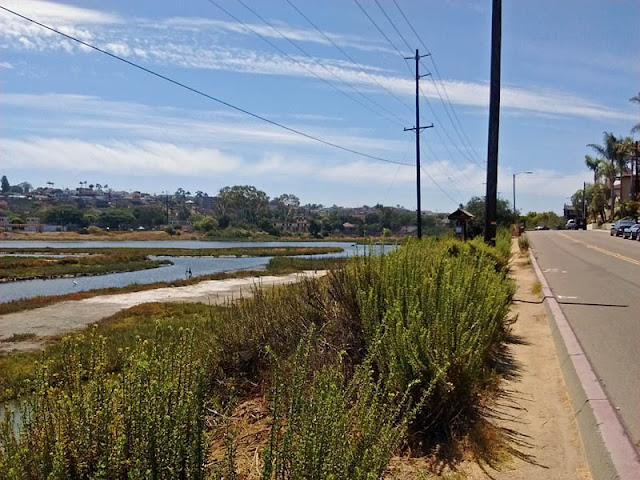These forests have resident mountain conifer birds not regularly found in the lowlands. These include Mountain Chickadees, Steller's Jays, Red-breasted Sapsuckers, Dark-eyed Juncos, and Purple Finches. The oaks provide for resident Acorn Woodpeckers, American Robins, Nuttall's Woodpeckers, Oak Titmouses, House Wrens, Band-tailed Pigeons, and White-breasted Nuthatches. Harder to find are Brown Creepers and Red-breasted Nuthatches. Winter may irregularly bring Varied Thrushes, Cassin's Finches, Pine Siskins, Evening Grosbeaks, Townsend's Solitaires, and Red Crossbills. Summer is always enjoyable--often with cool mornings (but check the forecast). Summer residents not found in the lowlands are Olive-sided Flycatchers, Purple Martins, and Cassin's Vireos. Common spring migrants in the mountains include Hermit Warblers, Townsend's Warblers, and Wilson's Warblers.
Two regular mountain forest birds that are easier to find in the Cuyamaca Mountains and the Laguna Mountains are Hairy Woodpeckers and Pygmy Nuthatches. They show up on Palomar Mountain, but not regularly. Also hard to find, in any of the mountains of San Diego County, are White-headed Woodpeckers, Williamson's Sapsuckers, Clark's Nutcrackers, and Pinyon Jays. Any are possible, but they may not even occur every year.
Here is an eBird bar chart for birds in several combined hotspots in Palomar Mountain State Park. Use the bar chart as a way to determine variety, abundance, and seasonality, but not necessarily accurate as to exact location.
You may enjoy reading "Hiking Lower Doane Valley and French Valley" on the Modern Hiker website.
 |
| click for larger view |
 |
| Trail map. click for larger view. |
Note: If you are thinking about taking Nate Harrison Road back down to CA-76, please note that it is a steep, rutted dirt road. It may or may not be passable with many 2 wheel drive vehicles--especially after rain. All other roads are paved and in good condition.
Cell phone coverage: Depending upon weather conditions and your carrier, you may get cell coverage at Silvercrest Picnic area (A on trail map) or Boucher Fire Lookout (C on trail map).
The trails on this map are generally well-maintained dirt. Some have steep, rocky, or muddy sections. The elevation here is about 5200 feet and it is easy to get winded. Go slow and take lots of photos and no one will know you are gasping for breath! Carry water. On only one hike outlined below are you more than a half mile from your vehicle. There are flush toilets and sinks at Silvercrest picnic area parking lot. There is a pit toilet at Doane Pond. There are additional pit toilets at Boucher Hill Lookout and restrooms at Cedar Grove and Doane Valley campgrounds. There is a restaurant just outside the park boundaries and additional campgrounds on the road to Palomar Observatory, which is only 4 miles away. Gas stations are 15 miles away, back down on the road to Valley Center. Fill with gas before you come. Bring all your food and drinks with you!
Warning: Poison oak is common throughout the park, both bush and vine types--especially in drier oak/chaparral in the Weir Trail and Silvercrest Trail areas. Another plant that causes blisters and itching similar (or worse!) than poison oak is poodle-dog bush.
Where to bird: Use the map to guide your birding on three trails, detailed more below. You probably can't bird all three trails in a single day--at least, not without missing a lot of birds. There are additional trails connecting these trails. Check local trail signs when you arrive. You are not in much danger of getting lost if you stay on the well-marked and well-used trails, so go explore!
1) Silvercrest Trail (A on the trail map): 1 mile loop.
2) Upper Doane Valley/Doane Pond/Thunder Spring (T on the trail map): 1.2 mile total walk, out and back, from Doane Pond parking lot (B on the trail map).
3) Lower Doane Valley/French Valley/Weir Trail (W on the trail map): 3.5 mile loop from Doane Pond parking lot (B on the trail map).
Silvercrest Trail
Starting at the Silvercrest Picnic area parking lot (A on the trail map) a thin dirt trail heads south along the west flank of the hill. There is a lot of low brush here, unfortunately much of what isn't bracken ferns is poison oak. Check the trail condition to see if overhanging bushes have recently been cut back. If not, walk down the road to the south about a quarter mile to the park's south boundary, watching birds until you come to where the Silvercrest trail crosses the road and heads toward a park ranger's home. Yes, a sign says "no unauthorized vehicles," but that is the hiking trail. The trail then turns north along an old orchard and then goes into the forest below the entry pay booth. The trail is a bit rough and steep coming back up to the parking lot.
 |
| Silvercrest Trail looking down onto Casino and Valley Center Road (and coastal morning fog). |
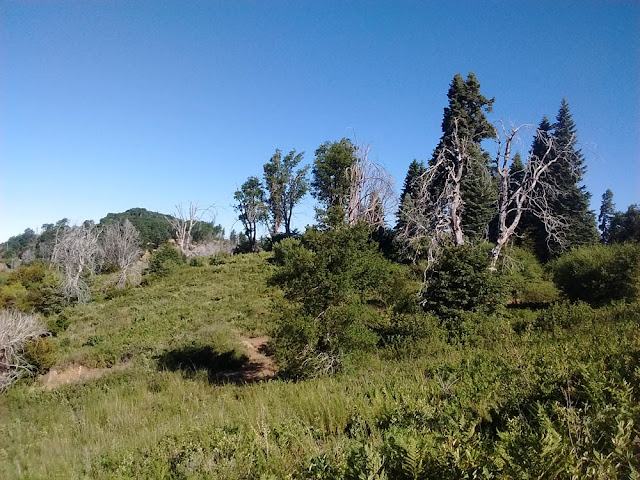 |
| Silvercrest Trail looking at Boucher Lookout |
 |
| Palomar Mountain State Park forest below fee booth |
 |
| Boucher Lookout |
Doane Pond and Upper Doane Valley trail to Thunder Spring
Drive 2 miles from Silvercrest Picnic area to Doane Pond parking lot (B on the trail map). The trail is about 0.6 miles from the parking lot, around Doane Pond, to Thunder Spring (T on the trail map). It is relatively flat. The spring is usually dry, in my experience. No thundering.
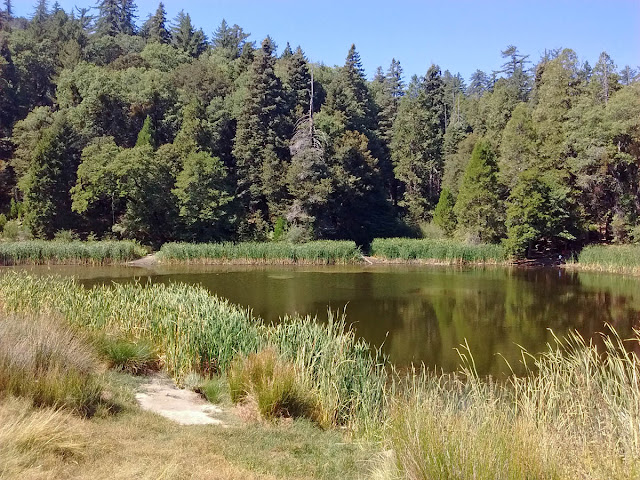 |
| Doane Pond |
 |
| Upper Doane Valley looking back toward Doane Pond and the parking lot |
 |
| Thunder Spring. Woo-hoo! |
The trail to Thunder Spring stays in the conifer-oak woods and follows a creek along the west edge of the meadow. This is perhaps the most reliable spot for Red-breasted Sapsuckers. Just be patient--they don't move much and it may be 10 minutes between bouts of drumming or giving their churring call. I've found Warbling Vireos here in summer more than once. They likely breed here, in addition to being rather common migrants. The woods here may surprise with Brown Creepers or Red-breasted Nuthatches.
Here is the eBird Hotspot information for Doane Pond.
Lower Doane Valley/French Valley/Weir Trail
This is my new favorite trail in Palomar Mountain State Park. It turns out I am just the second person to add a checklist for this eBird "hotspot." Check out my September 5, 2016 list here.
Parking is at the Doane Pond lot (B on the trail map). From the southwest corner of the lot the Weir Trail enters the woods, crosses the entry road, and follows a trickling Doane Creek northward into a damp(!) old growth forest of huge big cone Douglas-fir and white fir. How unexpected! If you do nothing else, follow this trail about 1.1 miles to the end of the Weir trail (W on the trail map) and back. This is where most of the birds will be--near the water.
On the other hand, you can cut back directly from the Weir Trail to the Doane Valley Campground without adding much more to the round trip. But I recommend following the French Valley Trail loop all the way around the meadow of ponderosa pine, into black oak woodland, to the campground, for a total of about 3.5 miles and an elevation change of 450 feet (highest near the campground, lowest at the Wier). I went slow, taking photos along the way, spending just over 3 hours on this beautiful and birdy trail.
 |
| Weir Trail near Doane Pond parking lot. Damp old growth forest! |
 |
| Weir Trail overlooking Lower Doane Valley |
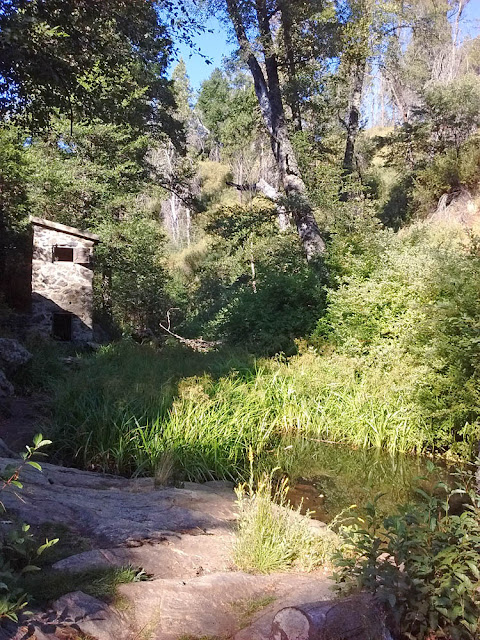 |
| The Weir at the end of Weir Trail |
As you leave the forest and get near the Weir, the creek gets more channeled and the surrounding area drier. So all the birds are there in the creek bottom puddles, bathing and drinking. The number of hummingbirds along the creek was amazing. All I saw were Anna's, but I suspect in July many might be migrating Rufous Hummingbirds. Costa's and Black-chinned are possible too. Allen's too. And maybe Calliope in spring. The chaparral above the creek had Bewick's and House Wrens. An Orange-crowned Warbler came in to look at me--either a resident bird or migrant.
I hit it good with flycatchers on my September trip. The Pacific-slope Flycatcher and Western Wood-Pewee are summer residents. But I also found a Willow Flycatcher and a Hammond's Flycatcher. Plus I had both of these fall migrants at Doane Pond. Actually, it is possible the Willow Flycatcher at the Weir was one of the rare breeding local forms.
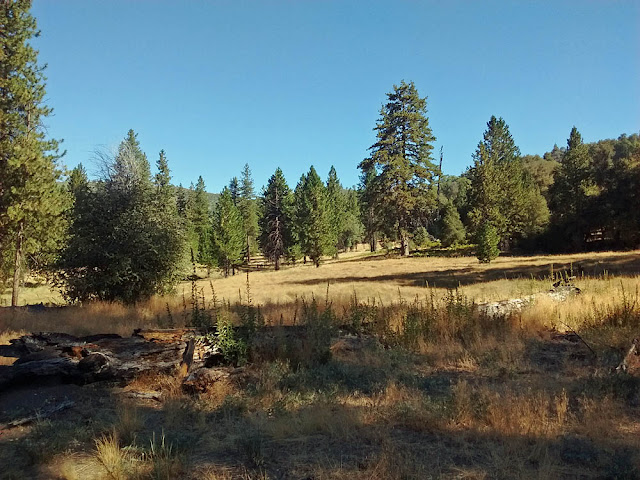 |
| French Valley Trail |
 |
| A huge black oak fallen over the trail. |
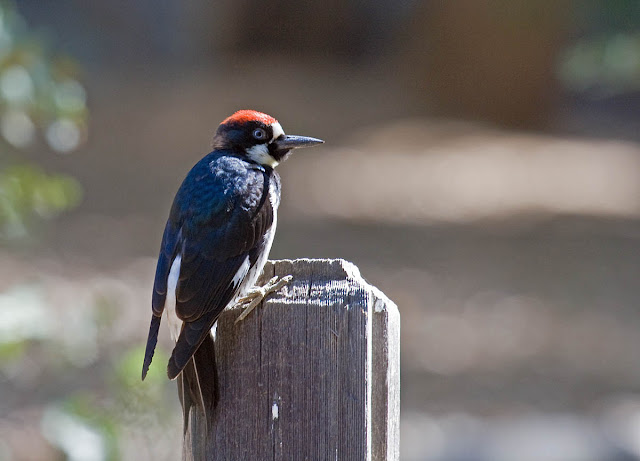 |
| Acorn Woodpecker |
 |
| Mountain Chickadee |
 |
| Palomar Observatory |








